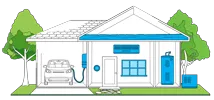Central Air Conditioners Tax Credit
This tax credit is effective for products purchased and installed between January 1, 2023, and December 31, 2032.
- How to Claim the Federal Tax Credits
- Strategies to Maximize Your Federal Tax Savings
- Claim the credits using the IRS Form 5695.
- Instructions for Form 5695
- Instructions for Form 5695 (Print Version - PDF)
YOU CAN CLAIM:
30%
of project cost
$600
maximum amount
credited
What products are eligible?
For split systems, ENERGY STAR certified equipment with SEER2 > 16 is eligible. All ENERGY STAR certified packaged systems are eligible.
Note: Under the tax code, eligible equipment must “meet or exceed the highest efficiency tier (not including any advanced tier) established by the Consortium for Energy Efficiency which is in effect as of the beginning of the calendar year.” The eligibility described above is consistent with this requirement.
Annual Limits on Energy Efficient Home Improvement Tax Credits
In addition to limits on the amount of credit you can claim for any particular equipment installation or home improvement, there are annual aggregate limits. The overall total limit for an efficiency tax credit in one year is $3,200. This breaks down to a total limit of $1,200 for any combination of home envelope improvements (windows/doors/skylights, insulation, electrical) plus furnaces, boilers and central air conditioners. Any combination of heat pumps, heat pump water heaters and biomass stoves/boilers are subject to an annual total limit of $2,000. (Note: ENERGY STAR certified geothermal heat pumps are eligible for a separate tax credit and not counted against these limits.)

Rebate Finder
Look for utility, state, and local rebates in your area.

At ENERGY STAR
Your go-to resource for the latest advice from ENERGY STAR experts on saving energy at home and work.
Who can use this credit?
Principal Residence Owners
Must be an existing home & your principal residence. New construction and rentals do not apply.
A principal residence is the home where you live most of the time. The home must be in the United States. It can include a house, houseboat, mobile home, cooperative apartment, condominium, and a manufactured home.
How can I maximize my tax credits?
Given the way the annual aggregate limits are structured, it may be prudent to spread your improvements over a few years. If your heating or cooling system is old, and you are considering a new air source heat pump, it is always wise to optimize your attic insulation first, so you don’t pay for more heating and cooling than you actually need. Making these upgrades together in one year would allow you a tax credit of up to $1,200 for the insulation and up to $2,000 for the heat pump. Similarly, you could combine a heat pump installation with window/door replacements. In that scenario, the $2,000 credit for the heat pump could be combined with tax credits up to $600 total for the windows/skylights plus $500 for two or more doors. If you replace your water heater the following year, you would be eligible for another 30% tax credit, up to $2,000 plus up to $600 if you need an electric panel upgrade to accommodate the new water heater.


